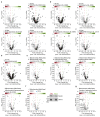Metabolic determination of cell fate through selective inheritance of mitochondria
- PMID: 35165416
- PMCID: PMC7612378
- DOI: 10.1038/s41556-021-00837-0
Metabolic determination of cell fate through selective inheritance of mitochondria
Abstract
Metabolic characteristics of adult stem cells are distinct from their differentiated progeny, and cellular metabolism is emerging as a potential driver of cell fate conversions1-4. How these metabolic features are established remains unclear. Here we identified inherited metabolism imposed by functionally distinct mitochondrial age-classes as a fate determinant in asymmetric division of epithelial stem-like cells. While chronologically old mitochondria support oxidative respiration, the electron transport chain of new organelles is proteomically immature and they respire less. After cell division, selectively segregated mitochondrial age-classes elicit a metabolic bias in progeny cells, with oxidative energy metabolism promoting differentiation in cells that inherit old mitochondria. Cells that inherit newly synthesized mitochondria with low levels of Rieske iron-sulfur polypeptide 1 have a higher pentose phosphate pathway activity, which promotes de novo purine biosynthesis and redox balance, and is required to maintain stemness during early fate determination after division. Our results demonstrate that fate decisions are susceptible to intrinsic metabolic bias imposed by selectively inherited mitochondria.
© 2022. The Author(s), under exclusive licence to Springer Nature Limited.
Conflict of interest statement
The authors declare no competing interests.
Figures














Comment in
-
Mitochondrial efficiency directs cell fate.Nat Cell Biol. 2022 Feb;24(2):125-126. doi: 10.1038/s41556-021-00834-3. Nat Cell Biol. 2022. PMID: 35165414 No abstract available.
References
-
- Vacanti NM, Metallo CM. Exploring metabolic pathways that contribute to the stem cell phenotype. Biochim Biophys Acta - Gen Subj. 2013;1830:2361–2369. - PubMed
-
- Chandel NS, Jasper H, Ho TT, Passegué E. Metabolic regulation of stem cell function in tissue homeostasis and organismal ageing. Nat Cell Biol. 2016;18:823–832. - PubMed
Publication types
MeSH terms
Substances
Grants and funding
LinkOut - more resources
Full Text Sources
Other Literature Sources
Research Materials

